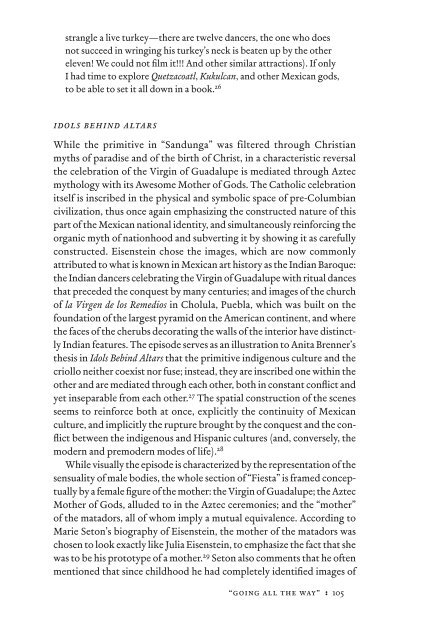In Excess: Sergei Eisentein's Mexico - Cineclub
In Excess: Sergei Eisentein's Mexico - Cineclub
In Excess: Sergei Eisentein's Mexico - Cineclub
Create successful ePaper yourself
Turn your PDF publications into a flip-book with our unique Google optimized e-Paper software.
strangle a live turkey—there are twelve dancers, the one who does<br />
not succeed in wringing his turkey’s neck is beaten up by the other<br />
eleven! We could not fi lm it!!! And other similar attractions). If only<br />
I had time to explore Quetzacoatl, Kukulcan, and other Mexican gods,<br />
to be able to set it all down in a book. 26<br />
idols behind altars<br />
While the primitive in “Sandunga” was filtered through Christian<br />
myths of paradise and of the birth of Christ, in a characteristic reversal<br />
the celebration of the Virgin of Guadalupe is mediated through Aztec<br />
mythology with its Awesome Mother of Gods. The Catholic celebration<br />
itself is inscribed in the physical and symbolic space of pre-Columbian<br />
civilization, thus once again emphasizing the constructed nature of this<br />
part of the Mexican national identity, and simultaneously reinforcing the<br />
organic myth of nationhood and subverting it by showing it as carefully<br />
constructed. Eisenstein chose the images, which are now commonly<br />
attributed to what is known in Mexican art history as the <strong>In</strong>dian Baroque:<br />
the <strong>In</strong>dian dancers celebrating the Virgin of Guadalupe with ritual dances<br />
that preceded the conquest by many centuries; and images of the church<br />
of la Virgen de los Remedios in Cholula, Puebla, which was built on the<br />
foundation of the largest pyramid on the American continent, and where<br />
the faces of the cherubs decorating the walls of the interior have distinctly<br />
<strong>In</strong>dian features. The episode serves as an illustration to Anita Brenner’s<br />
thesis in Idols Behind Altars that the primitive indigenous culture and the<br />
criollo neither coexist nor fuse; instead, they are inscribed one within the<br />
other and are mediated through each other, both in constant confl ict and<br />
yet inseparable from each other. 27 The spatial construction of the scenes<br />
seems to reinforce both at once, explicitly the continuity of Mexican<br />
culture, and implicitly the rupture brought by the conquest and the confl<br />
ict between the indigenous and Hispanic cultures (and, conversely, the<br />
modern and premodern modes of life). 28<br />
While visually the episode is characterized by the representation of the<br />
sensuality of male bodies, the whole section of “Fiesta” is framed conceptually<br />
by a female fi gure of the mother: the Virgin of Guadalupe; the Aztec<br />
Mother of Gods, alluded to in the Aztec ceremonies; and the “mother”<br />
of the matadors, all of whom imply a mutual equivalence. According to<br />
Marie Seton’s biography of Eisenstein, the mother of the matadors was<br />
chosen to look exactly like Julia Eisenstein, to emphasize the fact that she<br />
was to be his prototype of a mother. 29 Seton also comments that he often<br />
mentioned that since childhood he had completely identifi ed images of<br />
“going all the way” : 105


